Places nearby
PLACES TO VISIT IN ZARASAI DISTRICT
For four years now “Tundra” has been hosted by Zarasai District famous for its hills and lakes of exceptional beauty. Do you have any idea how interesting the surrounding areas are? Local people love nature (1, 2, 7, 8, 9, 10), know how to have fun (3), and have lots of energy (4, 5, 6). Be sure to visit and appreciate the places that the district is so proud of.
DUSETOS SCULPTURE PARK
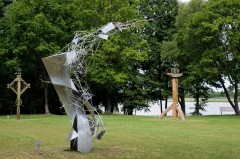 The idea to develop a sculpture park was born with the renovation of Sartai lakeside launched in 2006. The idea began to materialise and a small but imaginative outdoor exhibition of sculptures was opened in a lakeside recreation area in 2008. A walk in the park will help you test the limits of your perception: try to count how many sculptures you understood and boast about it when you come back to the Festival grounds.
The idea to develop a sculpture park was born with the renovation of Sartai lakeside launched in 2006. The idea began to materialise and a small but imaginative outdoor exhibition of sculptures was opened in a lakeside recreation area in 2008. A walk in the park will help you test the limits of your perception: try to count how many sculptures you understood and boast about it when you come back to the Festival grounds.
Address: K. Būgos Street in Dusetos, near the Dusetos council building (K. Būgos St 31a, Dusetos)
IEVA ZOO
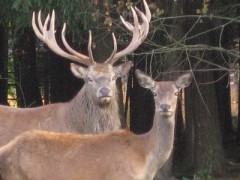 Sometimes, after a party, you feel you are not human. The visit to Ieva Zoo can help you understand the difference between an animal and a human being. The zoo hosts a variety of horned animals that has been growing since 2001. Here, you will realise that beside royal weddings there are also royal stags, that a moufflon is not the same as a mason, and that sika deer is called deer-fir in the Far East. The zoo has a long lasting educational effect.
Sometimes, after a party, you feel you are not human. The visit to Ieva Zoo can help you understand the difference between an animal and a human being. The zoo hosts a variety of horned animals that has been growing since 2001. Here, you will realise that beside royal weddings there are also royal stags, that a moufflon is not the same as a mason, and that sika deer is called deer-fir in the Far East. The zoo has a long lasting educational effect.
Address: Šlapiai village, Dusetos Subdistrict
A visit should be booked ahead by phone +370 686 32552
RAMŪNAS ČIŽAS BREWERY AND AN EXHIBITION OF ANCIENT BEER BREWING TOOLS
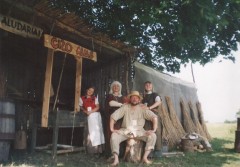 Čižas beer, recognised as Lithuanian culinary heritage, is a mug of beer brewing traditions and secrets from the Highlands. Do you know how beer was brewed in the region of Lake Sartai in the old days? Do you know the stages the crops had to pass to become beer? Ramūnas Čižas, a well known brewer from Zarasai District, will tell you the story if you visit his brewery where he has been brewing a number of superb beverages according to the formulae refined since 1863. In the process of fermentation of Čižas beer, sugar is replaced by honey collected by the bees kept by the brewer himself, thus ensuring a unique flavour and quality of the beer.
Čižas beer, recognised as Lithuanian culinary heritage, is a mug of beer brewing traditions and secrets from the Highlands. Do you know how beer was brewed in the region of Lake Sartai in the old days? Do you know the stages the crops had to pass to become beer? Ramūnas Čižas, a well known brewer from Zarasai District, will tell you the story if you visit his brewery where he has been brewing a number of superb beverages according to the formulae refined since 1863. In the process of fermentation of Čižas beer, sugar is replaced by honey collected by the bees kept by the brewer himself, thus ensuring a unique flavour and quality of the beer.
The exhibition of beer brewing tools is yet another hobby of the brewer from Dusetos region: he will be glad to tell you about the beer brewing tradition of his ancestors from the Highlands.
Address: Dusetos homestead, Dusetos Subdistrict
VENCAVAI WINDMILL
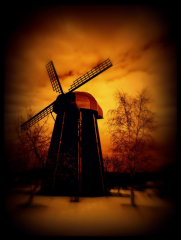 Wind is a very useful phenomenon. Some spit in the wind, some bend like straws in the wind, and sometimes you find your tent gone with the wind. Meanwhile, our ancestors – who were inherently environmentally friendly – knew how to harness the wind. An example of such lore can be found in Vencavai. Winds turned the blades of the mill from 1937 to 1956. The windmill was restored in 1980 and has been accepting visitors since then. Will you pay a visit too?
Wind is a very useful phenomenon. Some spit in the wind, some bend like straws in the wind, and sometimes you find your tent gone with the wind. Meanwhile, our ancestors – who were inherently environmentally friendly – knew how to harness the wind. An example of such lore can be found in Vencavai. Winds turned the blades of the mill from 1937 to 1956. The windmill was restored in 1980 and has been accepting visitors since then. Will you pay a visit too?
Address: Vencavai village, Dusetos Subdistrict
ANTALIEPTĖ HYDROELECTRIC POWER STATION
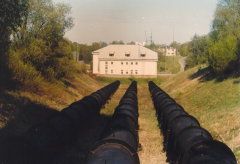 Antalieptė hydroelectric power station is an object of historical and technical heritage located in the territory of the former Gaideliai Manor, but it can be of interest not only to the fans of techno. The idea of a water power station here was born in 1937, but was implemented as late as in 1961. The dam had a huge impact on the landscape of Antalieptė – water flooded an area of 800 ha, connected 26 lakes and formed the Antalieptė Reservoir offering recreation to anyone wishing to swim in a vast body of water.
Antalieptė hydroelectric power station is an object of historical and technical heritage located in the territory of the former Gaideliai Manor, but it can be of interest not only to the fans of techno. The idea of a water power station here was born in 1937, but was implemented as late as in 1961. The dam had a huge impact on the landscape of Antalieptė – water flooded an area of 800 ha, connected 26 lakes and formed the Antalieptė Reservoir offering recreation to anyone wishing to swim in a vast body of water.
Address: Antalieptė village, Antalieptė Subdistrict
MUSEUM OF ENERGY
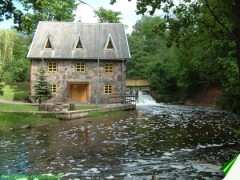
The museum exhibits a hand-made stone quern, a rich collection of old kerosene lamps and outdoor lanterns, early electrical devices, and gives a historical overview of the construction of Antalieptė hydroelectric power plant, and an introduction to the electrification scheme of Lithuania’s Eastern Highlands. You won’t be able to reclaim your energy lost during the Festival here, but you will sure find out about the ways our ancestors made electrical energy. Tiltiškiai stone watermill built on the bank of the Šventoji River is a witness of the long way Zarasai District had to walk from darkness to light.
Address: Tiltiškiai village, Salakas Subdistrict
STELMUŽĖ OAK
 Nobody knows how old the Stelmužė Oak is. According to a number of theories, the age of the tree ranges from 1500 years to more than 2000. Some call it the oldest oak in the whole Europe, while others give it a modest title of one of the oldest. But one thing is clear – it is an exceptional monument of nature that once shed its shadow on the warriors of the ancient Lithuania and the nearby pagan altar where sacrifices were offered to the god of thunder.
Nobody knows how old the Stelmužė Oak is. According to a number of theories, the age of the tree ranges from 1500 years to more than 2000. Some call it the oldest oak in the whole Europe, while others give it a modest title of one of the oldest. But one thing is clear – it is an exceptional monument of nature that once shed its shadow on the warriors of the ancient Lithuania and the nearby pagan altar where sacrifices were offered to the god of thunder.
Although the oak still looks magnificent and comes into leaf every spring, some of its branches are dead and some have been broken by storms. Experts maintain that careful maintenance of the gramps should keep it alive for the decades to come. However, it is never too early to pay a visit to the old-timer. Stelmužė Oak is waiting for you with its branches outstretched to the height of 23 meters. It has been waiting for a very very long time...
Address: Stelmužė village, Imbradas Subdistrict
LYGUMOS STONE (DEVIL’S STONE)
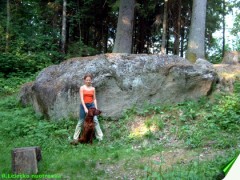 Lygumos Stone (also known as the Devil’s Stone) is one of the biggest stones in Lithuania and a relic from the times when devils seemed to have a liking for tossing stones all over the country. There is no precise data on the dimensions of the boulder – its major portion is covered by soil and it has not undergone archaeological investigation. Legend has it that the stone could hold as many as 30 hunters who would meet here to discuss issues. We keep wondering how many festival-goers would the stone hold?
Lygumos Stone (also known as the Devil’s Stone) is one of the biggest stones in Lithuania and a relic from the times when devils seemed to have a liking for tossing stones all over the country. There is no precise data on the dimensions of the boulder – its major portion is covered by soil and it has not undergone archaeological investigation. Legend has it that the stone could hold as many as 30 hunters who would meet here to discuss issues. We keep wondering how many festival-goers would the stone hold?
Address: Stelmužė village, Imbradas Subdistrict
SARTAI STUD FARM
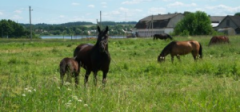
Lake Sartai has been famous for its horse racing on ice since the old times, but did you know that the trotters for the races are bred in the Sartai stud farm located in the village of Didžiadvaris on the lakeside? When the stud farm was established in 1967, the broodstock of racehorses was made up of Orlov trotters from Khrenovo stud farm and Russian trotters from other farms of Russia. Later, the bulky Little Samogitians were introduced to the farm – historians argue that the breed was used by the Grand Duchy of Lithuania as a war horse in the victorious Battle of Grunwald. And recently, in 2002, Lithuanian Heavy Draught joined the inhabitants of the farm. Over 140 prizes have been won in national races since the establishment of the stud farm. Visit the facility and find out, what the race course prize winners are up to once the ice is gone from Lake Sartai.
Address: Didžiadvaris village, Dusetos Subdistrict A visit should be booked ahead by phone +370 385 56867 or +370 385 56505
ŠAVAŠA EDUCATIONAL ROUTE
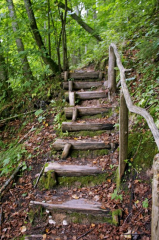 What is Šavaša? To find out, you will have to walk the 1.5 km long first Lithuanian geological path which follows the Šavaša River across Šavaša Landscape Reserve, Gražutė Regional Park. Visitors travelling from Daugailiai (Utena District) towards Antalieptė should take a right turn immediately before the bridge across the Šventoji River. Follow the river up the hill until you see the view of Antalieptė, and – further down the road – Lūžai Mound on the left. This is Šavaša – a real mountain river. The educational route consists of 7 stations: the Beaver Lodge station will tell you about the sharp-toothed forest rodents; the Key Forest Lodge station will introduce you to the region’s biodiversity, including the vulnerable and the endangered species; the Lūžai Forest station will offer a view of the variety of tree species; while the Petrographic station will give you knowledge of the origin and distribution of rocks, and an opportunity to see the Lūžai mythological stone, which is all that remains of the 16th century Lithuanian temple; the Geomorphological station set up on an 8 m high riverbank will introduce you to the science of the shapes, origins and processes of ground surface; the Fluvial station will tell you about the erosion and accumulation of soil caused by rivers; while the last station is intended to explain How stones came into being (the knowledge that every stoner has to posses).
What is Šavaša? To find out, you will have to walk the 1.5 km long first Lithuanian geological path which follows the Šavaša River across Šavaša Landscape Reserve, Gražutė Regional Park. Visitors travelling from Daugailiai (Utena District) towards Antalieptė should take a right turn immediately before the bridge across the Šventoji River. Follow the river up the hill until you see the view of Antalieptė, and – further down the road – Lūžai Mound on the left. This is Šavaša – a real mountain river. The educational route consists of 7 stations: the Beaver Lodge station will tell you about the sharp-toothed forest rodents; the Key Forest Lodge station will introduce you to the region’s biodiversity, including the vulnerable and the endangered species; the Lūžai Forest station will offer a view of the variety of tree species; while the Petrographic station will give you knowledge of the origin and distribution of rocks, and an opportunity to see the Lūžai mythological stone, which is all that remains of the 16th century Lithuanian temple; the Geomorphological station set up on an 8 m high riverbank will introduce you to the science of the shapes, origins and processes of ground surface; the Fluvial station will tell you about the erosion and accumulation of soil caused by rivers; while the last station is intended to explain How stones came into being (the knowledge that every stoner has to posses).
Address: For more information or the services of a guide along the route, please contact the Gražutė Regional Park Administration by phone +370 385 59426, +370 682 33041, or by e-mail parkas@grazute.lt
